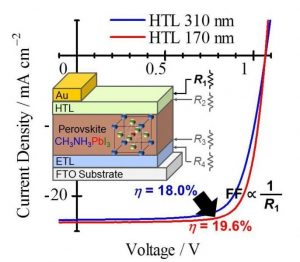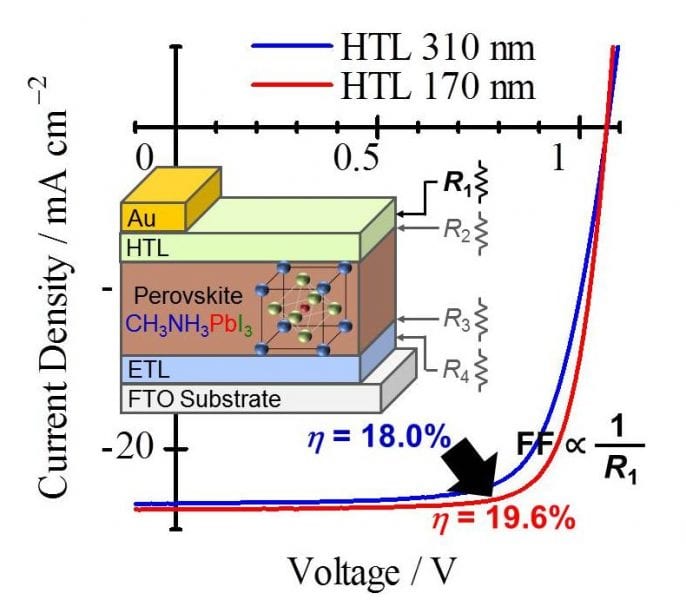Photovoltaic (PV) devices are regarded as some of the most promising power sources because the cost for generating electricity can be much lower than that for fossil fuels. Lead-halide perovskite solar cells are PV devices that have attracted much attention due largely to their unique advantages such as light-weight, flexibility, high throughput productivity, large-area production with low-cost printing processes, and excellent opto-electronic properties. More importantly, their PV efficiency has rapidly increased from 3.8% in 2009 to more than 22% in 2017.
However, in order to realize the drastic cost reduction compared to the widely available silicon-based devices, a further improvement in PV efficiency of perovskite solar cells is vital. To achieve this, the efficiency-limiting factors of lead-halide perovskite solar cells must be tackled.
 The solar cell efficiency is typically defined as a ratio of the output energy via PV cell to the input energy from the incident sunlight, which can be evaluated from the product of three PV parameters: the short-circuit current density (JSC), the open-circuit voltage (VOC), and the fill factor (FF). The FF is defined as the ratio of the maximum power from PV cells to the product of JSC and VOC. Although many studies have been done on the upper limits of JSC and VOC in perovskite solar cells until now, little is known about the upper limit of FF. This is partly because the FF in most perovskite devices depends on the voltage sweep direction (from minus voltage to plus voltage or from plus voltage to minus voltage). Therefore, it has not been easy to assess the marginal efficiency of perovskite solar cells quantitatively.
The solar cell efficiency is typically defined as a ratio of the output energy via PV cell to the input energy from the incident sunlight, which can be evaluated from the product of three PV parameters: the short-circuit current density (JSC), the open-circuit voltage (VOC), and the fill factor (FF). The FF is defined as the ratio of the maximum power from PV cells to the product of JSC and VOC. Although many studies have been done on the upper limits of JSC and VOC in perovskite solar cells until now, little is known about the upper limit of FF. This is partly because the FF in most perovskite devices depends on the voltage sweep direction (from minus voltage to plus voltage or from plus voltage to minus voltage). Therefore, it has not been easy to assess the marginal efficiency of perovskite solar cells quantitatively.
In a recently published article in Solar-RRL, researchers have fabricated CH3NH3PbI3 perovskite solar cells with different thicknesses of the hole-transporting layer. In addition, they examined the thickness-dependent FF on the basis of an empirical equation where the diode parameters depend on the voltage scan directions separately. As a result, this equation can explain the thickness-dependent FF well and it can potentially be applied to the estimation of FF in perovskite solar cells. On the basis of this equation, the potential improvements in FF and efficiency of perovskite solar cells are discussed, and this quantitative analysis gives a guideline for further optimization of the cells’ photovoltaic performance.
The text was generously supplied by Kim et al. and edited by Ekaterina Perets.














